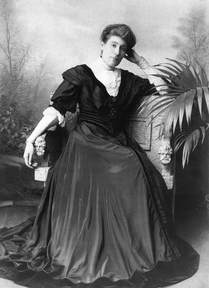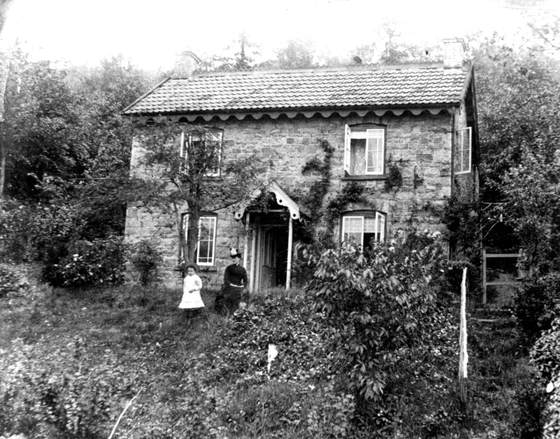FLORA KLICKMANN
|
1867-1958
A prolific and successful writer she gained international fame through her hugely successful Flowerpatch series. The books were based around life in the Forest of Dean village of Brockweir. For much of her career Flora divided her time between London and the village, retiring to the Wye Valley permanently following her departure from the Girls Own Paper in 1930 and her husband’s retirement. |
Life and career
|
Emily Flora Klickmann was born on 26 January 1867 in Brixton, South London. Her father, Rudolph Friedrich Auguste, was a German immigrant. He was sponsored by a Miss Meredith who found work for him at her brother’s timber yard, where he worked for the rest of his life until the age of 75. Miss Meredith introduced him to Flora’s mother, Frances (Fanny) Warne. The second of six children, only Flora and two others survived childhood. After the deaths of the young children, the family moved to Sydenham, (at that time a rural area).
Flora planned to be a musician, and graduated from Trinity College of Music, London, and also studied at the Royal College of Organists. She was amongst the first women to play the huge organ at the Crystal Palace. However, her musical career was cut short at the age of 20 when she was found to be suffering from the heart condition arrhythmia. With music no longer an option, Flora turned to journalism as a less stressful career, and became a professional writer (articles and books) and editor. She was editor of the Girls Own Paper from 1908 to 1930 and wrote or edited some thirty other books and pamphlets on subjects such as etiquette, knitting and sewing. In 1913, age 46, Flora married Ebenezer Henderson Smith, an executive involved in The Girls’ Own Paper. He was 62, widowed with seven grown children. They appear to have enjoyed a companionable marriage, spending the week in their large home in Sydenham Hill in London and their weekends in the Wye Valley. Ebenezer died in 1937. She had no children, but was close to her brother Martin’s son, Brian Kingslake (Martin having changed his name during WW1). The books that brought her international fame and are connected with the Forest of Dean, are the Flower Patch series. Initially written as a hastily put together article to fill a gap in the Girls Own Paper, Flora’s humorous and insightful articles of village life in and around Brockweir became so popular that she published the first book, The Flower Patch Among the Hills, in 1916. It was reprinted only two weeks later and in its first year there were seven reprints. Five more books followed at intervals over the years until 1933, but her last book was not published until 1948, when Flora was 80. The books brought her international fame and many visitors to Brockweir, who would trudge up the hill from Brockweir Halt in search of Buttercup Cottage - Flora’s weekend home, formerly (and now again) called Sylvan House, and the setting for the books. Flora’s association with Brockweir was through her mother’s two sisters, Emily and Lucy Warne, who lived there in Rosewell Cottage. For much of her career, Flora divided her time between London and Brockweir, retiring to the Wye Valley permanently following her departure from the Girls Own Paper in 1930 and her husband’s retirement. |
The Flower-Patch SeriesThe Flower-Patch Among the Hills (1916) Between the Larch Woods and the Weir (1917) The Trail Of The Ragged Robin (1921) Flower-Patch Neighbours (1928) Visitors At The Flower-Patch (1931) The Flower-Patch Garden Book (1933) Weeding the Flower-Patch (1948) OTHER BOOKS
Little Sunshine Picture Book (n.d., ca 1890)
The Rainy-Day Picture Book (1896) From Nursery Land (1897) At The Seaside (1897) How To Behave (editor, 1898) In Make-Believe Land (1899) The Language Of Flowers (1899) How To Dress (1900) In Pinafore-Land (1900) The Picture Gallery Of Animals (1900) The Lever That Moves The World (1903) Songs Of The Land Of The Stars And Stripes (1903) Etiquette Of To-Day (1903) The Ambitions Of Jenny Ingram (1911) The Home Art Crochet Book (editor, 1912) The Home Art Book of Fancy Stitchery (editor, 1912) The Craft of the Crochet Hook (editor, 1912) The Modern Crochet Book (editor, 1913) Artistic Crochet (editor, 1914) Flower Pictures (editor, 1914) The Cult of the Needle (editor, c.1914) The Mistress of the Little House (editor, 1915) The Modern Knitting Book (editor, 1915) The Little Girl's Knitting and Crochet Book (editor, 1915) The Little Girl's Sewing Book (editor, c.1915) Outdoor Pictures (editor, 1915) Beautiful Crochet on Household Linen (editor, 1916) The Little Girl's Bird Book (editor, 1917) Hardanger and Cross-Stitch (editor, 1918) The Little Girl's Fancy Work (editor, 1919) Needlework Economies (editor, 1919) Distinctive Crochet (editor, 1919) Pillow Lace and Hand-Worked Trimmings (editor, 1920) The Lure Of The Pen: A Book For Would-be Authors (1920) The Popular Knitting Book (editor, 1921) The Little Girl's Cooking Book (editor, 1923) The Little Girl's Sweet Book (editor, 1923) The Shining Way (1923) The Path to Fame (1925) Mending Your Nerves (1925) The Carillon of Scarpa (1925) Many Questions Answered (1928) The Lady-With-The-Crumbs (1931) Mystery In The Windflower Wood (1932) Delicate Fuss (1932) Victorian Fancy Stitchery: Techniques & Designs (2003 reprint of The Home Art Book of Fancy Stitchery) Victorian Needlework: Techniques & Designs (2003 reprint of The Cult of the Needle) This list is sourced from Wikipedia |
Assessment
The Flower Patch books show Flora to be very much a writer of her time and her genteel position in society. The series has no plot or story as such - they are tales from her own experiences of life in London and, more often, life in the Wye Valley, written in the first person and told in a lively manner. Educated and humorous, her flowing command of the language translates often into poetic descriptions of the countryside and its woodland creatures, which might then end in some whimsical manner which brings a smile even today.
Take this, for example, which is the opening paragraph of The Trail of the Ragged Robin, the fourth in her Flower Patch series:
‘If you have ever wandered in the Valley of the Wye, you will know something of its straggling hillside paths – always steep, always stony, always beautiful, and always calculated to reduce any boots to a hopeless state of disrepair.’
Her anthropomorphic treatment of woodland creatures, and especially the birds which flocked around the cottage, tempted by tasty treats lavishly strewn on window ledges (and even on indoor tables by open windows) would make Disney proud! Here she follows the daily routines, and troubles, of a mating pair of blackbirds she has named Martha and Augustus:
'I never knew a bird with as many grudges and grievances as Augustus seems to have. He “chut-chuts” at me if I’m late with his breakfast.'
Flora was not at all above poking fun at people too - the locals (rich or poor) and also the many friends and acquaintances who “just happen to be passing” whenever she is staying at the cottage, and even her dearly-loved female companions (and herself too!), all suffer the same from her amused pen. But she is most respectful of the country wisdom of the locals. In this section, London visitors pay a call on a local farmer, who ‘had no particular grievance against either the weather or his crops or the Government. But he had a supreme contempt for the many amateurs who embark on various species of farming nowadays.’
“But how do they manage to carry on if they’ve had no sort of training?” Mr Author inquired.
“Well, first they reads the farming papers; then they buys barrer loads of books and studies ’em a lot, while the cows are a-bellowing to be milked; then they puts the milk in the churn; and after that they just sits down and sends along for my missus!”’
Her anecdotes are very often at the expense of her more sophisticated friends:
‘A lady of intellectual eminence, who was visiting us, studied a Wellingtonia tree, which is about fifty foot high, very broad at the base and tapering to a point. At last she asked the gardener – “How do you get up to cut it that shape?”
Politely surprised, the man replied, “In these parts, we just leaves ’em to grow, ma’am; it seems the easiest way.”
It is easy to see how her stories appealed to the world at large, especially those written during and shortly after WW1, when Flora and the local people took the shortages and privations of that time with typical British stoicism and more than a pinch of humour. Take the tale of Miss Primkins, an elderly neighbour, for example:
Take this, for example, which is the opening paragraph of The Trail of the Ragged Robin, the fourth in her Flower Patch series:
‘If you have ever wandered in the Valley of the Wye, you will know something of its straggling hillside paths – always steep, always stony, always beautiful, and always calculated to reduce any boots to a hopeless state of disrepair.’
Her anthropomorphic treatment of woodland creatures, and especially the birds which flocked around the cottage, tempted by tasty treats lavishly strewn on window ledges (and even on indoor tables by open windows) would make Disney proud! Here she follows the daily routines, and troubles, of a mating pair of blackbirds she has named Martha and Augustus:
'I never knew a bird with as many grudges and grievances as Augustus seems to have. He “chut-chuts” at me if I’m late with his breakfast.'
Flora was not at all above poking fun at people too - the locals (rich or poor) and also the many friends and acquaintances who “just happen to be passing” whenever she is staying at the cottage, and even her dearly-loved female companions (and herself too!), all suffer the same from her amused pen. But she is most respectful of the country wisdom of the locals. In this section, London visitors pay a call on a local farmer, who ‘had no particular grievance against either the weather or his crops or the Government. But he had a supreme contempt for the many amateurs who embark on various species of farming nowadays.’
“But how do they manage to carry on if they’ve had no sort of training?” Mr Author inquired.
“Well, first they reads the farming papers; then they buys barrer loads of books and studies ’em a lot, while the cows are a-bellowing to be milked; then they puts the milk in the churn; and after that they just sits down and sends along for my missus!”’
Her anecdotes are very often at the expense of her more sophisticated friends:
‘A lady of intellectual eminence, who was visiting us, studied a Wellingtonia tree, which is about fifty foot high, very broad at the base and tapering to a point. At last she asked the gardener – “How do you get up to cut it that shape?”
Politely surprised, the man replied, “In these parts, we just leaves ’em to grow, ma’am; it seems the easiest way.”
It is easy to see how her stories appealed to the world at large, especially those written during and shortly after WW1, when Flora and the local people took the shortages and privations of that time with typical British stoicism and more than a pinch of humour. Take the tale of Miss Primkins, an elderly neighbour, for example:
‘Miss Primkins has been hard hit by the War, but no matter how she has to skimp and save in other ways she never relaxes her work for the wounded. And it was about her contribution to Queen Mary’s Needlework Guild that she came up to consult me. Not that we started there straightaway – of course not....Then .... she produced (in an undertone) a paper parcel from her bag, and with much hesitation explained that she wanted advice on a private matter.
I was all attention.
Undoing the paper, she displayed what looked like a round bolster case made of pink and blue striped flannelette. As she held it up for inspection, it “flared” at the top ... with merely a small round opening at the bottom.
I glanced over it as intelligently as I knew how, and then inquired what it was.
“It’s a pyjama for a soldier,’ she murmured modestly, in a very low voice. “I’ve cut it exactly by the paper pattern, yet Miss Judson, who saw it yesterday, says she doesn’t believe it’s right...”
“Er – h’m– ah –yes,” I said, as light dawned. “It’s all right as far as it goes; but where’s the other leg?”
“The other leg?” she echoed, “there was only one in the pattern.”
”Of course; but you should have cut it out in double material; the garment requires two legs, you know.”
“Does it!” she exclaimed, in genuine surprise. “Why, I thought it must be intended for a soldier who had had his other leg amputated!”
But Flora wasn’t all fun and jokes. As this piece shows, she could also be serious and contemplative and her attachment to her Brockweir cottage ran very deep:
We wanted beauty
We desired a touch of heavenliness
We sought a haven of rest
We went in hope, love, and longing
And The Flower Patch did not deny us.
Sources
The Forest of Dean Local History journal, The New Regard, No 27, 2013 has an article written by Charlie Miles and Cheryl Mayo which gives a detailed account of Flora’s life and her work. The material here, written by Cheryl, draws on that article.
The Forest of Dean Local History journal, The New Regard, No 27, 2013 has an article written by Charlie Miles and Cheryl Mayo which gives a detailed account of Flora’s life and her work. The material here, written by Cheryl, draws on that article.
comments
Have you enjoyed any of Flora's books? Tell us what you think here - or send your thoughts via our contact page...




